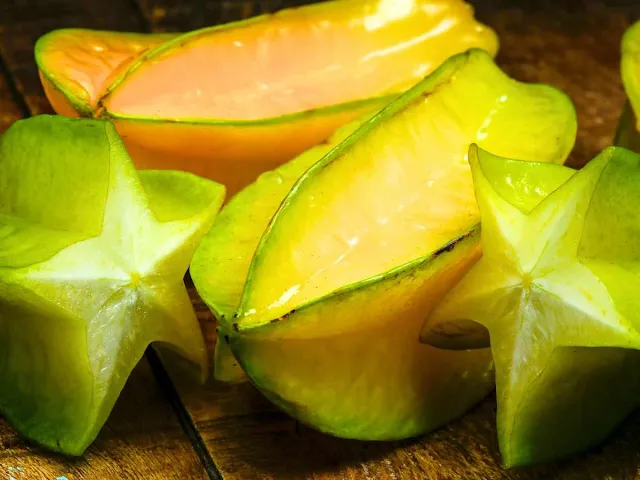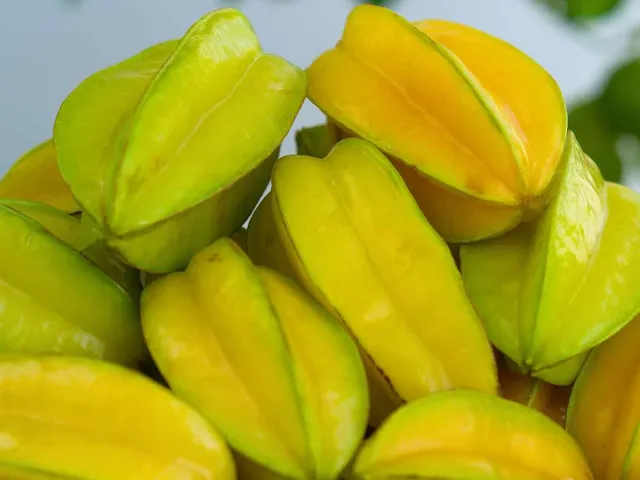Eating Carambola: Its Benefits and Harms
Carambola (scientific name Averrhoa carambola) is a native fruit that is well known to everyone. However, there is a question in the minds of many about whether eating Carambola is beneficial for health or harmful. There is a popular belief that eating Carambola in particular causes kidney damage.

This article discusses in detail the benefits and harms of consuming carambola (based on scientific data). Continue reading till the end to know if you should eat carambola and bilimbi (a fruit of the genus Averrhoa bilimbi) and if so, how much.
Nutrition Facts of Carambola
Carambola is a sour fruit that can be eaten both raw and ripe. Carambola looks green when raw and turns yellow when ripe. Carambola is called star fruit in English because it looks like a star when cut.
Carambola is a very low-calorie fruit. A medium-sized (weighing 91 grams) Carambola contains 6 grams of carbohydrates which provides 28 calories. But Carambola is a fruit rich in vitamins (especially vitamin C) and anti-oxidants.

| Nutrition: | Quantity: |
|---|---|
| Fiber | 3 grams |
| Protein | 1 gram |
| Vitamin C | 52 percent |
| Vitamin B5 | 4 percent |
| Vitamin B9 | 3 percent |
| Copper | 6 percent |
| Potassium | 3 percent |
| Magnesium | 2 percent |
Health Benefits of Carambola
Carambola contains vitamin C and antioxidants that boost the body's immune system. And the immune system helps you stay healthy by fighting off pathogens.
Carambola regulates cholesterol
High levels of bad cholesterol (LDL) in the blood and low levels of good cholesterol (HDL) increase the risk of heart disease. High blood pressure or hypertension is seen especially in those who have high cholesterol levels in their blood. Patients with high blood pressure have a higher risk of heart attack and stroke.
Studies have shown that eating Carambola increases the level of good cholesterol in the blood and can play a role in controlling bad cholesterol.
Carambola reduces the risk of diabetes
Animal studies have shown that Carambola helps reduce the risk of diabetes. However, research on humans is needed to know this for sure.
Carambola has a very low glycemic index, meaning that eating Carambola does not raise blood glucose levels. Considering this aspect, Carambola is quite useful as a snack for diabetic patients compared to other fruits.
However, diabetic patients are at a higher risk of developing kidney problems. And eating Carambola has been linked to kidney problems. So diabetic patients shouldn't eat Carambola considering kidney problems.
Carambola acts as an anti-inflammatory

Carambola contains anti-oxidants that act as anti-inflammatory agents. That is, it controls the number of free radicals in the body, prevents premature cell death, and heals inflammation. It plays a helpful role in curing various inflammatory diseases such as arthritis, liver inflammation, Alzheimer's, etc.
Other roles of carambola
Various diseases are caused by viral, bacterial, and fungal infections. The vitamin C and anti-oxidants present in carambola play a role in fighting infection.
Carambola has a role in reducing the risk of ulcers. Eating carambola may be beneficial for cancer prevention. Anti-oxidants present in carambola help control the growth of cancer cells.
Carambola health risks
Carambola contains toxic substances called carambola and oxalates that can have harmful effects on health. Especially in those with kidney problems, these toxic substances cannot be filtered out of the body through the kidneys. This results in more damage to the kidneys and severe reactions in the nervous system.
How to eat Carambola?

Carambola can be pickled and eaten. However, raw or ripe Carambola is most beneficial if consumed directly without cooking. Because it does not have a chance to lose vitamins and anti-oxidants in the heat of fire.
Eating Carambola in moderation is safe and beneficial for healthy individuals. But it cannot be eaten every day. That is, Carambola cannot be eaten continuously for a long time but should be eaten occasionally.
Carambola should not be consumed more than 2 times a day. Also, avoid eating Carambola on an empty stomach.
Carambola and bilimbi should not be consumed by those with kidney problems. Carambola and Bilimbi should also be avoided by those at high risk of developing kidney disease. For example:
- Hypertensive patients
- A person with diabetes
- Those with a family history of kidney disease
Pregnant women and those on long-term medication should follow their doctor's advice on consuming Carambola.
Last word
Carambola is a readily available fruit that is rich in vitamins and antioxidants. Carambola is not said to cause kidney damage in healthy people. Rather, Carambola can be eaten occasionally (in moderation ie 1/2 a day). However, people with kidney problems or those who are at risk of kidney disease should not eat carambola.
FAQs:
What vitamins does a carambola contain?
Carambola has many beneficial ingredients like Vitamin A, and Vitamin C. Per 100 grams of Carambola 50 kilocalories of food energy, 0.5 grams of protein, 0.1 grams of fat, and 5.1 grams of carbohydrates.
What is the harm of eating carambola fruit?
100 ml of carambola juice contains 0.50 g of oxalic acid. As a result, oxalic acid accumulates and turns into oxalate stones. If carambola is consumed in excess, it can cause kidney damage.
Does the carambola contain any acid?
Carambola contains ellagic acid, which prevents esophageal cancer. Also, carambola has many properties. Its leaves and young fruits are all medicinal. Carambola leaves and young fruit juice contain tannins, which help in blood clotting.







